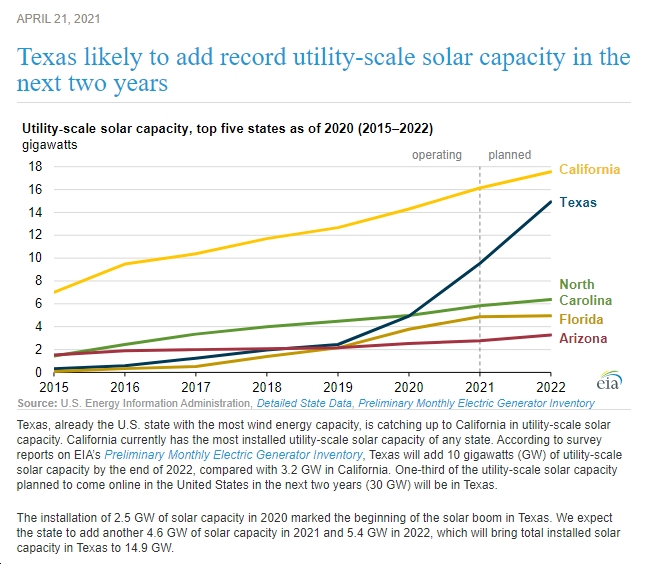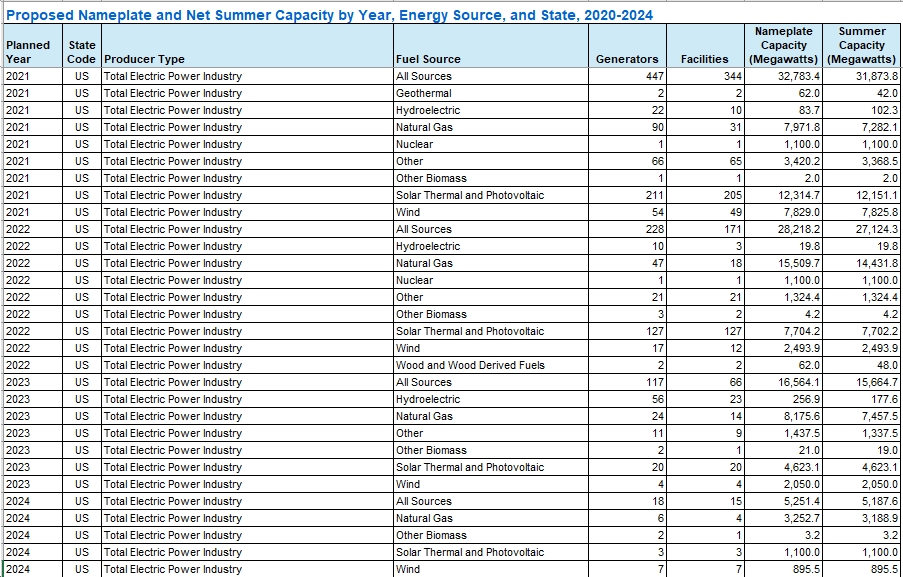 According to a post today by the U.S. Energy Information:
According to a post today by the U.S. Energy Information:
Texas, already the U.S. state with the most wind energy capacity, is catching up to California in utility-scale solar capacity. California currently has the most installed utility-scale solar capacity of any state. According to survey reports on EIA’s Preliminary Monthly Electric Generator Inventory, Texas will add 10 gigawatts (GW) of utility-scale solar capacity by the end of 2022, compared with 3.2 GW in California. One-third of the utility-scale solar capacity planned to come online in the United States in the next two years (30 GW) will be in Texas.
The installation of 2.5 GW of solar capacity in 2020 marked the beginning of the solar boom in Texas. We expect the state to add another 4.6 GW of solar capacity in 2021 and 5.4 GW in 2022, which will bring total installed solar capacity in Texas to 14.9 GW.
Which is great news for Texas, of course, given that solar power is clean, cheap, reliable, etc, etc. Also, as you can see from the graphic, other leading solar power states are California, North Carolina, Florida and Arizona. Now, obviously, most of those states are some combination of a) huge; b) very sunny. But at least one of those states, North Carolina, isn’t much different than Virginia when it comes to size and solar power potential. So where’s Virginia, exactly? As you can see from the following data table on “Proposed Nameplate and Net Summer Capacity by Year, Energy Source, and State, 2020-2024,” the U.S. as a whole added or is expected to add:
- 44.9 GW of electric power capacity in 2020, of which 23.5 GW was wind power, 13.5 GW was solar power, and much of the rest (6.6 GW) natural gas-fired power.
- 31.9 GW of electric power capacity in 2021, of which 12.2 GW is solar power, 7.8 GW is wind power, and 7.3 GW is natural gas-fired power.
- 27.1 GW of electric power capacity in 2022, of which 14.4 GW is natural gas-fired power, 7.7 GW is solar power, and 2.5 GW is wind power.
- 15.7 GW of electric power capacity in 2023, of which 7.5 GW is natural gas-fired power, 4.6GW is solar power and 2.1 GW is wind power.
- 5.2 GW of electric power capacity in 2024, of which 3.2 GW is natural gas-fired power, 1.1 GW is solar power and 0.9 GW is wind power.
Of course, future U.S. power generation capacity additions will grow as more proposed projects are added. But for now, at least, there’s still way too much natural gas in there for 2022, 2023 and 2024. At this point, given the favorable economics of wind and solar, plus the urgency of the climate crisis making it crystal clear that we need to transition from dirty to clean energy as quickly as possible, there’s really no excuse for ever building a new fossil-fuel-fired power plant in the United States again. So what the heck is natural gas still doing on this list?!? Is more legislation required, even after passage of the Virginia Clean Economy Act, or what? Time for a fossil fuel moratorium, perhaps? Whatever, let’s address this problem ASAP.

As for Virginia, EIA has the following in terms of power generation capacity additions:
- Virginia added 902 MW of electric power capacity in 2020, all of which was solar power. Which is, obviously, excellent news!
- Virginia is slated to add 793 MW of electric power capacity in 2021, of which 705 MW is solar power and 84 MW is wind. Again, excellent!
- For 2022, though, EIA lists 1,257 MW of total electric power capacity, of which a whopping 1,060 MW is natural-gas-fired power, and just 197 MW of solar. That’s NOT good. At all. C’mon, let’s get that natural-gas-fired power the hell outta there!
- There’s nothing listed for 2023, but for 2024, EIA shows 1,672 MW of power generating capacity additions in Virginia, *all of which* is slated to be natural-gas-fired power. Totally unacceptable, and definitely a job for the next governor…actually, the current governor as well!
Bottom line: There shouldn’t be a single megawatt of additional power generating capacity built in Virginia, ever again, that spews greenhouse gas emissions into the atmosphere. Instead, we should be going all-out to transition to clean energy, treating the climate crisis AS A CRISIS, and focusing our efforts on energy efficiency (the cheapest “form” of energy), solar (utility-scale and distributed/rooftop) and wind (for Virginia, that will overwhelmingly be *offshore* wind, since that’s where the enormous resource is located).





![Monday News: Trump’s Lunacy Pushes China, Russia, India, etc. Together; “Happy Labor Day. Donald Trump and Elon Musk Are Screwing Workers.”; “Where is the [media’s] intense focus on Trump’s failing health?”; ““Trump says he is not a dictator. Isn’t he?”](https://bluevirginia.us/wp-content/uploads/2025/09/montage0901-238x178.jpg)









